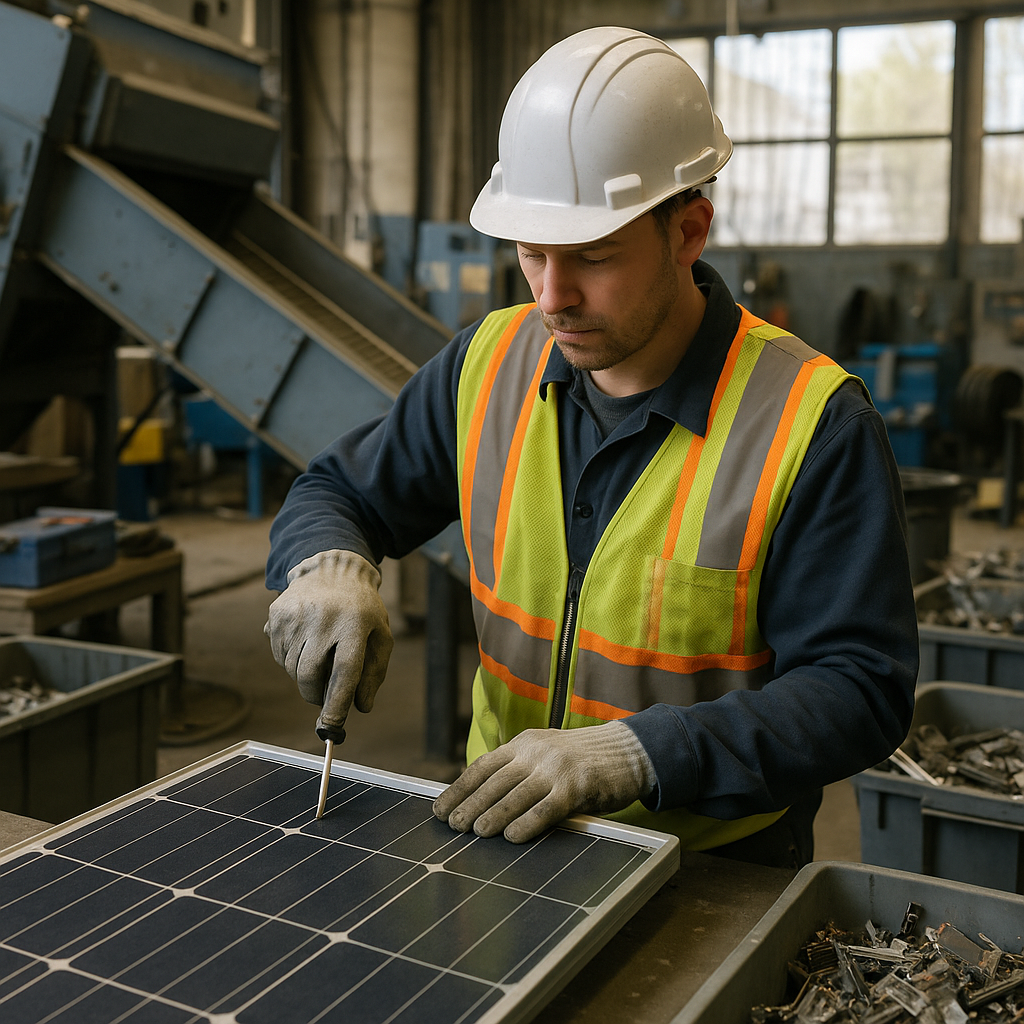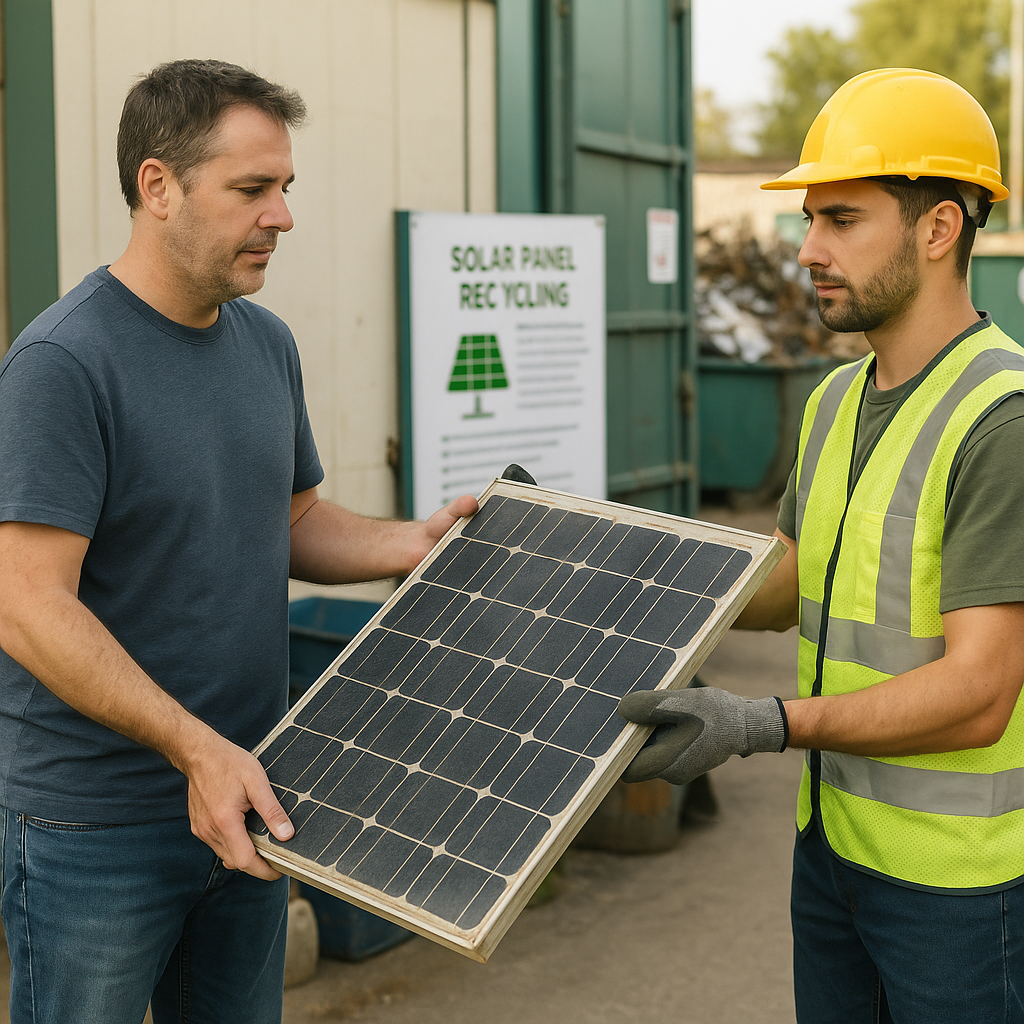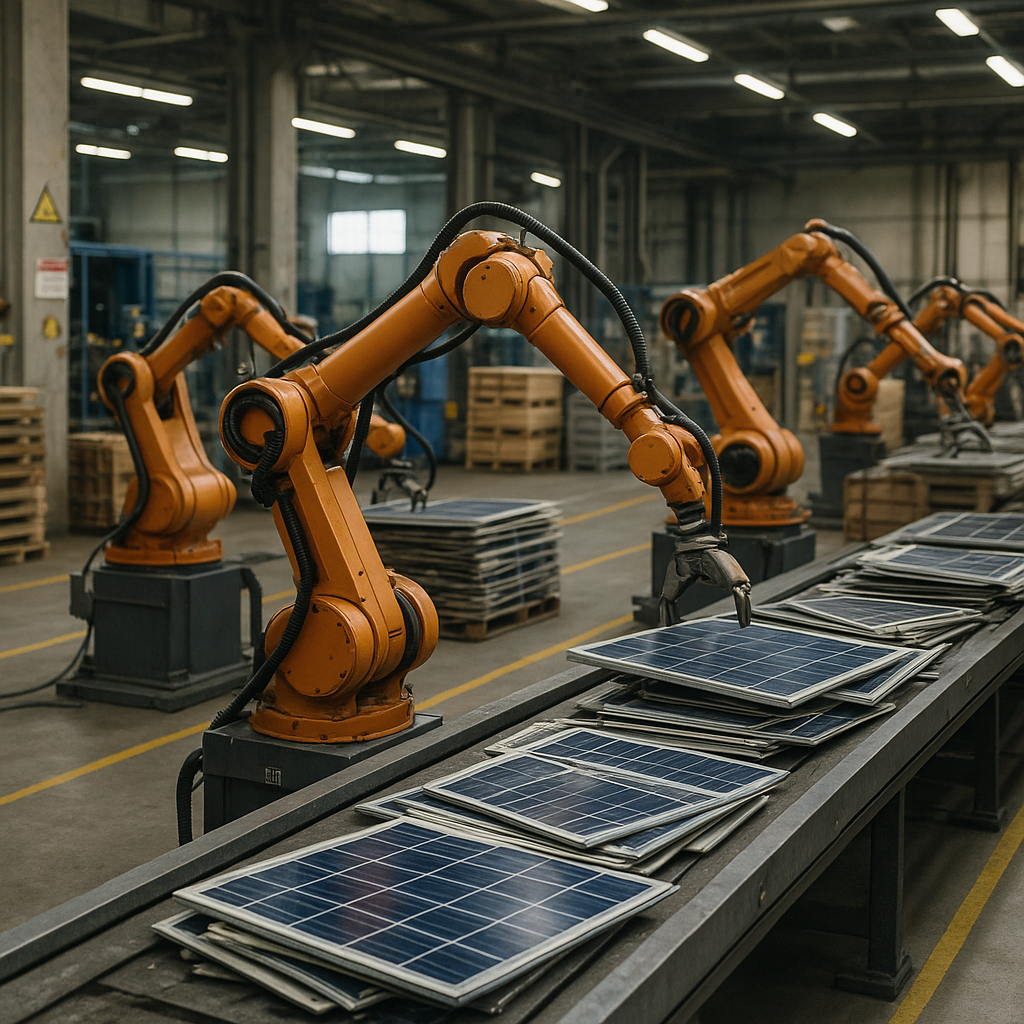5901 Botham Jean Blvd, Dallas, TX 75215
What Are the Challenges of Recycling Damaged Solar Panels?
June 9, 2025Solar energy is leading the renewable energy movement. Global photovoltaic capacity has increased from just 1.4 GW in 2000 to an impressive 760 GW in 2020. However, this remarkable growth presents a challenge. Millions of solar panels installed over the past decades are nearing the end of their 25-30 year lifespan.
Recycling damaged solar panels poses significant challenges for waste management facilities. Current recycling processes often require more resources and energy than manufacturing new panels. This economic imbalance leads many companies to opt for simpler solutions like landfill disposal or exporting waste to developing countries.
The environmental stakes are particularly high. Solar panels contain hazardous materials, including lead, cadmium, and other toxic substances. If improperly disposed of, these elements can leach into soil and groundwater. Experts project that by 2030, approximately 8 million metric tons of solar panel waste will accumulate globally, increasing to 80 million metric tons by 2050.
What are the Methods for Recycling Damaged Solar Panels?

Recycling damaged solar panels requires specialized techniques to recover valuable materials while minimizing environmental impact. Two primary methods have emerged as industry standards: mechanical processing and thermal treatment. These approaches work together to break down complex panel structures into reusable components.
Mechanical Processing
Mechanical processing serves as the initial stage in solar panel recycling. This method focuses on physically dismantling and separating panel components through several key steps.
First, technicians manually remove the aluminum frames and junction boxes. These components are easily separated and can be recycled through conventional metal recycling channels without further treatment.
Next, the remaining panel components undergo crushing and shredding. Specialized machinery reduces panels to smaller fragments, making it easier to separate different materials. These fragments then pass through a series of separation processes.
Separation techniques include sieving, air separation, and magnetic separation. Each method targets specific materials based on their physical properties. For example, magnetic separation effectively removes ferrous metals from the mixture.
Through mechanical processing, recyclers can recover:
- Glass (approximately 70% of panel weight)
- Aluminum from frames
- Copper from wiring and connectors
- Plastics from backing materials
While mechanical processing effectively recovers these materials, it has limitations in extracting high-value components like silicon cells and precious metals. This is where thermal treatment becomes essential.
Thermal Treatment
Thermal treatment applies heat to break down panels further and recover materials that mechanical processing alone cannot efficiently separate. This method is particularly effective for accessing silicon cells embedded in polymer layers.
The process typically involves heating shredded panel materials to temperatures exceeding 500°C. At these temperatures, the polymer encapsulants (usually ethylene-vinyl acetate or EVA) melt away from the silicon cells and glass.
Once the polymers are removed, the silicon cells become accessible for recovery and purification. The recovered silicon can be reused in new solar panels or other applications requiring silicon materials.
Thermal treatment enables the recovery of:
- Silicon from photovoltaic cells
- Silver from electrical contacts
- Lead from soldering materials
- Other rare or precious metals
Some advanced thermal processes also incorporate pyrolysis, which breaks down materials in an oxygen-free environment. This technique reduces harmful emissions while efficiently separating components.
Chemical Processing
As recycling technology advances, chemical processing increasingly complements mechanical and thermal treatments. This method uses various chemical solutions to dissolve and separate specific components.
For instance, chemical baths can dissolve the metallic connections between silicon cells and other components. These solutions can selectively extract materials like silver and copper, which have significant economic value.
Chemical etching techniques also help recover high-purity silicon by removing impurities and coatings. The purified silicon can then be repurposed for new solar cells or other electronic applications.
Material recovery through chemical processing focuses on:
- High-purity silicon
- Precious metals (silver, gold)
- Rare earth elements
- Gallium and indium (from thin-film panels)
The combination of mechanical, thermal, and chemical processes creates a comprehensive recycling system that maximizes resource recovery from damaged solar panels. This integrated approach supports circular economy principles by returning valuable materials to the production cycle.
As recycling technology continues to evolve, new methods aim to increase efficiency and reduce costs. Innovations like automated disassembly systems and more precise material separation techniques promise to make solar panel recycling more economically viable while further reducing environmental impact.
| Recycling Method | Material Recovery Rate |
|---|---|
| Standard Processes | 84.6% |
| Advanced Thermal and Chemical Processes | 98% |
| Hydrometallurgical and Electrochemical Methods for Silver | 98% |
| Iron Chloride and Aluminum Chloride Solutions for Silver | 90% |
| Electrodeposition-Redox Replacement for Silver | 98.7% |
| First Solar’s Process for Cd and Glass | 95% for Cd, 90% for Glass |
| PV Circonomy’s Automated Technology | 99.3% |
What are the Legal and Industry Standards for Solar Panel Disposal?
In the United States, solar panel disposal is regulated under the Resource Conservation and Recovery Act (RCRA). This federal framework sets the baseline for managing end-of-life solar panels, focusing on preventing environmental hazards from toxic components. The RCRA establishes guidelines for classifying, handling, and disposing of potentially hazardous waste materials.
Solar panels typically contain metals like lead, silver, and cadmium. When these panels reach the end of their useful life, they must undergo a toxicity characteristic leaching procedure (TCLP). This test determines whether panels qualify as hazardous waste. Results vary widely among different panel models and manufacturers, with some passing and others failing based on leachable metal content.
The Environmental Protection Agency (EPA) is developing a proposed rule to add solar panels to universal waste regulations. This change would streamline end-of-life management, encourage recycling, and potentially reduce environmental impact. The proposal aims to balance environmental protection and practical waste management.
State-Level Regulations
Many states have implemented their own approaches to solar panel management. California, for example, classifies solar panels as universal waste, simplifying handling requirements while maintaining environmental safeguards. It gives panel owners up to one year to properly recycle or dispose of waste panels before penalties apply.
Washington state has established a Photovoltaic Module Stewardship and Takeback Program, mandating recycling rather than landfill disposal. Hawaii has also adopted universal waste regulations specifically for solar panels. New Jersey created a Solar Panel Recycling Commission to develop long-term strategies for panel management.
North Carolina is working toward a regulatory framework through its Department of Environmental Quality and Environmental Management Commission. These state-level approaches demonstrate the growing recognition of solar panel waste as a challenge requiring specialized management strategies.
Industry Standards and Initiatives
The International Renewable Energy Agency (IRENA) has been instrumental in developing global guidelines for solar panel end-of-life management. Their recommendations focus on implementing circular economy principles to maximize material recovery and minimize environmental impact. These guidelines serve as reference points for recycling facilities and policymakers worldwide.
The National Renewable Energy Laboratory (NREL) significantly contributes to research and standard development, focusing on sustainable recycling technologies and environmentally responsible decommissioning methods. NREL research helps bridge gaps between current practices and future needs in the solar recycling sector.
The Solar Energy Industries Association (SEIA) collaborates with the Department of Energy to develop best practices for panel decommissioning and recycling. Their collaboration has resulted in practical guidelines for solar companies and waste management facilities. SEIA also promotes manufacturer participation in recycling programs.
Despite these advances, significant cost disparities exist between recycling and landfilling options. Recycling a silicon photovoltaic module costs between $15 and $45, while landfill disposal costs only $1 to $5. This economic reality creates challenges for widespread adoption of recycling practices. Transportation costs further impact the financial equation, potentially adding $12 to $25 per panel.
What are the Environmental Impacts of Solar Panel Disposal?

Improper disposal of solar panels poses significant environmental risks. These panels contain hazardous substances like lead and cadmium, which can leach into soil and contaminate water sources when they end up in landfills. The release of these toxins threatens local ecosystems and human health.
The environmental consequences extend beyond direct contamination. When panels aren’t recycled, valuable materials are wasted, necessitating additional mining and extraction of raw materials. This process leads to further environmental degradation through habitat disruption, energy consumption, and carbon emissions.
Benefits of Proper Solar Panel Recycling
Recycling solar panels offers substantial environmental benefits. According to EPA projections, recovered materials from recycled solar panels could be worth approximately $450 million by 2030. This economic incentive aligns with environmental protection goals.
The recovery process significantly reduces waste volume. Recycling allows for the reclamation of valuable metals, silicon, and glass that would otherwise occupy landfill space. Up to 95% of semiconductor materials and 90% of glass from panels can be recovered and repurposed.
The aluminum recovery process is particularly efficient. Recycling aluminum from solar panel frames requires 95% less energy than producing new aluminum from raw bauxite. This energy savings directly translates to reduced carbon emissions in the solar manufacturing process.
Building a Circular Economy for Solar Panels
Proper recycling creates a circular economy within the solar industry. Recovered materials can be redirected back into manufacturing, reducing dependence on virgin resource extraction. This closed-loop system supports sustainable development through resource conservation.
The reintroduction of recycled materials into production helps lower the overall environmental footprint of solar energy. When materials like silicon, silver, copper, and aluminum are recovered, the carbon footprint associated with mining and refining new materials decreases substantially.
This approach to managing end-of-life solar panels transforms what could be an environmental liability into a valuable resource stream. Instead of contributing to waste problems, decommissioned panels become a source of materials for new sustainable technologies.
How Can Consumers Ensure Proper Disposal of Damaged Solar Panels?

When solar panels reach the end of their useful life or become damaged, proper disposal is essential. Most solar panels have a lifespan of about 25 years, but they may need replacement sooner due to storms, accidents, or manufacturing defects. Responsible disposal prevents harmful materials from reaching landfills while recovering valuable resources.
Solar panels contain small amounts of valuable materials like aluminum, copper, silver, and glass that can be recycled. Some panels may also contain trace amounts of regulated materials requiring proper handling. Understanding your options is the first step toward environmentally responsible disposal.
Contact Specialized Recycling Services
Specialized solar panel recycling companies have the equipment and expertise to dismantle panels and recover materials safely. These facilities can recycle more than 95% of a crystalline silicon panel. When searching for a recycler, look for companies that operate under recognized standards like SERI’s R2 Standard or the e-Stewards certification.
You can find solar panel recycling facilities through resources like Earth911’s recycling directory or the Solar Energy Industries Association (SEIA) recycling program. Some recyclers offer pick-up services while others provide drop-off locations for your convenience.
Check with Your Solar Panel Manufacturer
Many solar panel manufacturers operate take-back and recycling programs for their products. Before disposing of damaged panels, contact the original manufacturer to see if they offer recycling services. This option is particularly important for thin-film panels, which may require specialized recycling processes.
Some manufacturers partner with recycling facilities to ensure their panels are processed properly at end-of-life. This closed-loop approach supports the circular economy and can sometimes be the most straightforward disposal option.
Understand Your Local Regulations
Solar panel disposal regulations vary significantly by location. In some states, like California and Washington, specific laws govern solar panel disposal and recycling. California classifies solar panels as universal waste, which triggers specific handling requirements.
Contact your state environmental agency or local waste management department to understand the regulations in your area. This step is crucial as improper disposal may result in penalties and environmental harm.
Utilize Hazardous Waste Collection Services
If specialized recycling isn’t available in your area, hazardous waste collection facilities may accept solar panels. These facilities ensure proper handling of materials that shouldn’t enter conventional waste streams.
Many counties and municipalities operate periodic hazardous waste collection events where residents can bring materials like solar panels for proper disposal. Check your local government website for information about upcoming collection events.
Consider Second-Life Options
Before recycling, consider whether your panels could have a second life. Even panels with reduced efficiency can still generate electricity. There are growing marketplaces for used solar panels that connect sellers with buyers seeking affordable solar options.
Organizations like Habitat for Humanity sometimes accept solar panel donations for use in their building projects. This approach extends the panels’ useful life and provides clean energy to those who might not otherwise afford it.
By researching and utilizing these responsible disposal options, consumers help minimize environmental impact while supporting the sustainable growth of renewable energy technologies. Proper end-of-life management is an essential part of solar energy’s environmental benefits.
Conclusion: The Future of Solar Panel Recycling

As the solar industry grows rapidly, the need for effective recycling solutions for end-of-life panels is becoming crucial. The solar recycling market is expected to grow significantly, from about $323 million in 2024 to potentially $931 million by 2030. This growth reflects the industry’s dedication to completing the circular economy loop for renewable energy technologies.
Significant challenges remain in standardizing processes, improving economic viability, and developing robust collection systems. However, ongoing innovations in recycling technologies offer hope. Advanced separation techniques, automated disassembly systems, and improved material recovery methods are steadily transforming a problematic waste stream into a valuable resource. These developments, along with evolving regulatory frameworks and industry standards, are laying the foundation for truly sustainable solar energy.
For your solar panel recycling needs, contact Okon Recycling at 214-717-4083.
